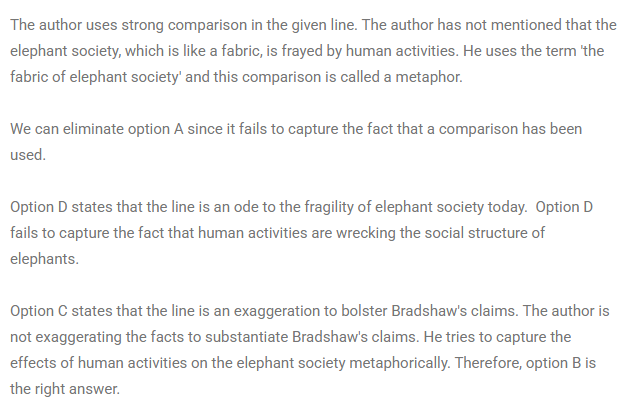CAT RC Questions | CAT RC- Social Science questions
FundaMakers is the Best CAT Online Coaching In India. Now prepare for CAT anytime with FundaMakers. We provide well-ordered syllabus coverage for both offline and online CAT preparation batches. FundaMakers brings to you the power-packed, well-structured CAT previous year question bank with more than 4000+ CAT Past Year questions. In the VARC section, one of the most frequently asked questions is from the topic- Reading Comprehension. Reading Comprehension turns out to be an important part of the VARC section from which over 60-70% of the questions are based on RC in the CAT Exam.
FundaMakers as a team has taken a painstaking step to bring you all the video solutions of the Reading Comprehension asked in the Previous Year CAT exam. CAT question bank offered by FundaMakers is a power-packed topic-wise compilation of the entire CAT previous year questions. Questions from the Reading Comprehension topic are some of the most scoring questions in the VARC section. To maximize your CAT score make use of FundaMakers CAT Question Bank. “Questions from CAT previous years” examination papers have been incorporated. Let’s get started with CAT Past Year Reading Comprehension Questions.
Comprehension
Directions for question: Read the passage carefully and answer the given questions accordingly.
“Everybody pretty much agrees that the relationship between elephants and people has dramatically changed,” [says psychologist Gay] Bradshaw. “Where for centuries humans and elephants lived in relatively peaceful coexistence, there is now hostility and violence. Now, I use the term ‘violence’ because of the intentionality associated with it, both in the aggression of humans and, at times, the recently observed behavior of elephants.”
Typically, elephant researchers have cited, as a cause of aggression, the high levels of testosterone in newly matured male elephants or the competition for land and resources between elephants and humans. But, Bradshaw and several colleagues argue that today’s elephant populations are suffering from a form of chronic stress, a kind of species-wide trauma. Decades of poaching and culling and habitat loss, they claim, have so disrupted the intricate web of familial and societal relations by which young elephants have traditionally been raised in the wild, and by which established elephant herds are governed, that what we are now witnessing is nothing less than a precipitous collapse of elephant culture.
Elephants, when left to their own devices, are profoundly social creatures. young elephants are raised within an extended, multi-tiered network of doting female caregivers that includes the birth mother, grandmothers, aunts and friends. These relations are maintained over a life span as long as 70 years. Studies of established herds have shown that young elephants stay within 15 feet of their mothers for nearly all of their first eight years of life, after which young females are socialized into the matriarchal network, while young males go off for a time into an all-male social group before coming back into the fold as mature adults.
This fabric of elephant society, Bradshaw and her colleagues [demonstrate], ha[s] effectively been frayed by years of habitat loss and poaching, along with systematic culling by government agencies to control elephant numbers and translocations of herds to different habitats. As a result of such social upheaval, calves are now being born to and raised by ever younger and inexperienced mothers. Young orphaned elephants, meanwhile, that have witnessed the death of a parent at the hands of poachers are coming of age in the absence of the support system that defines traditional elephant life. “The loss of elephant elders,” [says] Bradshaw "and the traumatic experience of witnessing the massacres of their family, impairs normal brain and behavior development in young elephants.”
What Bradshaw and her colleagues describe would seem to be an extreme form of anthropocentric conjecture if the evidence that they’ve compiled from various elephant researchers weren’t so compelling. The elephants of decimated herds, especially orphans who’ve watched the death of their parents and elders from poaching and culling, exhibit behavior typically associated with post-traumatic stress disorder and other trauma-related disorders in humans: abnormal startle response, unpredictable asocial behavior, inattentive mothering and hyper-aggression.
[According to Bradshaw], “Elephants are suffering and behaving in the same ways that we recognize in ourselves as a result of violence. Except perhaps for a few specific features, brain organization and early development of elephants and humans are extremely similar.”
CAT/2018.1
Question . 158
In paragraph 4, the phrase, “The fabric of elephant society . . . has(s) effectively been frayed by . . .” is:
Explanatory Answer
Method of solving this CAT RC Question from RC- Social Science question
Correct Option: B

Hey!
Worried about IIM calls due to your marks in 10th,12th, and Graduation?
Don't worry! Know your chances of getting an IIM Call based on your profile with our:-
Profile Professor: https://fundamakers.com/profile-professor/

5 Must- NOT-Dos during CAT Preparation.
- Do not treat CAT as 'Everything'.
- Do not quit your job for CAT exam preparation.
- Learning till The Eleventh hour instead of doing proper revision.
- Not checking the syllabus thoroughly.
- Piling up multiple books.
Click To Read:- Common mistakes made by CAT aspirants during preparation.
FundaMakers- Best Online and Offline CAT Online Preparation Institute in India
For any CAT Preparation related query, reach out to us at 9598333344.